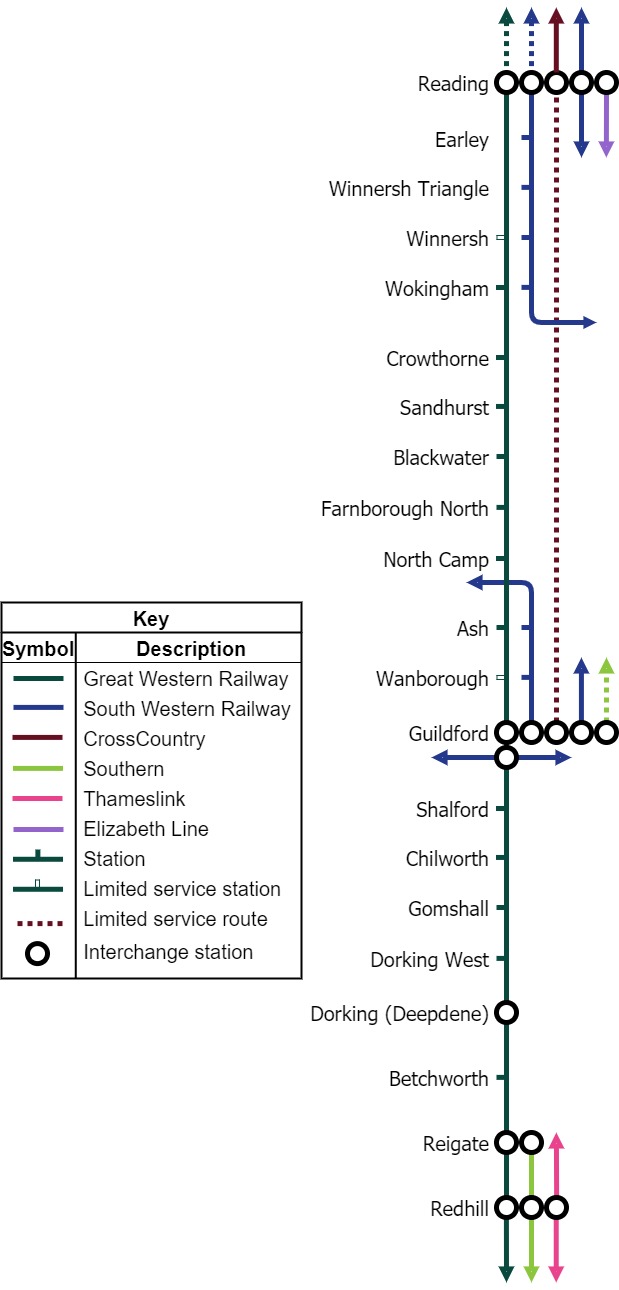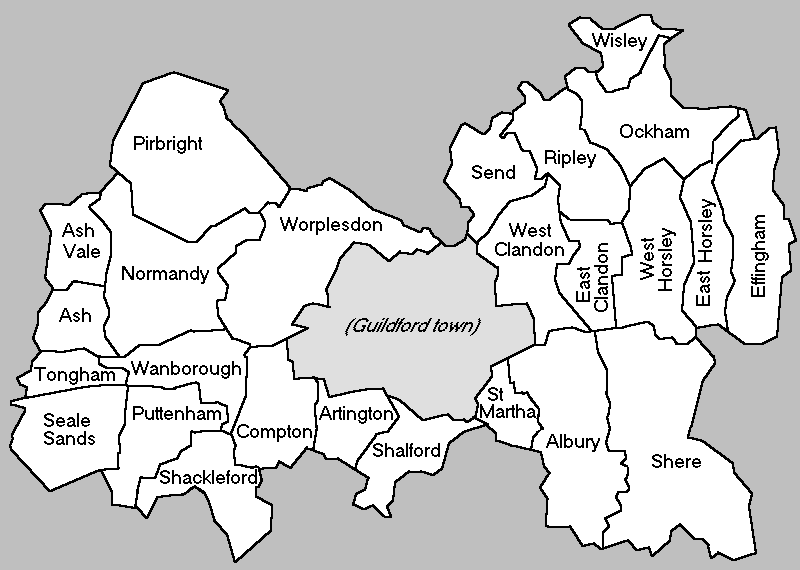|
Shalford Railway Station
Shalford railway station serves the village of Shalford, Surrey, England. The station, and all trains serving it, are operated by Great Western Railway. It is on the North Downs Line. The station is from , and has two platforms, which can each accommodate a six-coach train. To the west is Shalford Junction, from Charing Cross, where the North Downs Line meets the Portsmouth Direct Line from Waterloo (via ). History In 1940, Shalford was a sub-control centre coordinating the evacuation trains dispersing the soldiers brought back from Dunkirk. On 11 April 1944 two goods trains collided at Shalford Station. One of them consisted of tankers of aviation fuel en route to airfields in Kent. Leaks from the damaged wagons caused a major fire which was eventually brought under control by the fire brigade, with assistance of members of the local police and Home Guard Home guard is a title given to various military organizations at various times, with the implication of an emer ... [...More Info...] [...Related Items...] OR: [Wikipedia] [Google] [Baidu] |
Shalford, Surrey
Shalford is a village and civil parish in Surrey, England on the A281 Horsham road immediately south of Guildford. It has a railway station which is between Guildford and Dorking on the Reading to Gatwick Airport line. It has one named locality, occupying the west of the area, Peasmarsh. Shalford's village sign was designed by Christopher Webb and W H Randall Blacking in 1922, as part of a competition run by the Daily Mail. It shows Saint Christopher carrying the Christ Child over a shallow ford. History Shalford appears in the Domesday Book of 1086 as ''Scaldefor''. It was held by Robert de Wateville from Richard Fitz Gilbert. Its Domesday assets were: 4 hides; 1 church, 3 mills worth 16s, 11½ ploughs, of meadow, wood worth 20 hogs. It rendered £20. The village also became well known for "the Great Fair of Shalford" which was set up by a charter issued by King John. In its heyday, it was said to have covered 140 acres (570,000 m²) and attracted merchants from a ... [...More Info...] [...Related Items...] OR: [Wikipedia] [Google] [Baidu] |
Railway Stations In Great Britain Opened In 1849
Rail transport (also known as train transport) is a means of transport that transfers passengers and goods on wheeled vehicles running on rails, which are incorporated in tracks. In contrast to road transport, where the vehicles run on a prepared flat surface, rail vehicles (rolling stock) are directionally guided by the tracks on which they run. Tracks usually consist of steel rails, installed on sleepers (ties) set in ballast, on which the rolling stock, usually fitted with metal wheels, moves. Other variations are also possible, such as "slab track", in which the rails are fastened to a concrete foundation resting on a prepared subsurface. Rolling stock in a rail transport system generally encounters lower frictional resistance than rubber-tyred road vehicles, so passenger and freight cars (carriages and wagons) can be coupled into longer trains. The operation is carried out by a railway company, providing transport between train stations or freight customer facil ... [...More Info...] [...Related Items...] OR: [Wikipedia] [Google] [Baidu] |
Former South Eastern Railway (UK) Stations
A former is an object, such as a template, gauge or cutting die, which is used to form something such as a boat's hull. Typically, a former gives shape to a structure that may have complex curvature. A former may become an integral part of the finished structure, as in an aircraft fuselage, or it may be removable, being using in the construction process and then discarded or re-used. Aircraft formers Formers are used in the construction of aircraft fuselage, of which a typical fuselage has a series from the nose to the empennage, typically perpendicular to the longitudinal axis of the aircraft. The primary purpose of formers is to establish the shape of the fuselage and reduce the column length of stringers to prevent instability. Formers are typically attached to longerons, which support the skin of the aircraft. The "former-and-longeron" technique (also called stations and stringers) was adopted from boat construction, and was typical of light aircraft built until the ... [...More Info...] [...Related Items...] OR: [Wikipedia] [Google] [Baidu] |
Railway Stations In Surrey
Rail transport (also known as train transport) is a means of transport that transfers passengers and goods on wheeled vehicles running on rails, which are incorporated in Track (rail transport), tracks. In contrast to road transport, where the vehicles run on a prepared flat surface, rail vehicles (rolling stock) are directionally guided by the tracks on which they run. Tracks usually consist of steel rails, installed on Railroad tie, sleepers (ties) set in track ballast, ballast, on which the rolling stock, usually fitted with metal wheels, moves. Other variations are also possible, such as "slab track", in which the rails are fastened to a concrete foundation resting on a prepared subsurface. Rolling stock in a rail transport system generally encounters lower friction, frictional resistance than rubber-tyred road vehicles, so passenger and freight cars (carriages and wagons) can be coupled into longer trains. The rail transport operations, operation is carried out by a ... [...More Info...] [...Related Items...] OR: [Wikipedia] [Google] [Baidu] |
Home Guard (United Kingdom)
The Home Guard (initially Local Defence Volunteers or LDV) was an armed citizen militia supporting the British Army during the Second World War. Operational from 1940 to 1944, the Home Guard had 1.5 million local volunteers otherwise ineligible for military service, such as those who were too young or too old to join the regular armed services (regular military service was restricted to those aged 18 to 41) and those in reserved occupations. Excluding those already in the armed services, the civilian police or civil defence, approximately one in five men were volunteers. Their role was to act as a secondary defence force in case of invasion by the forces of Nazi Germany. The Home Guard were to try to slow down the advance of the enemy even by a few hours to give the regular troops time to regroup. They were also to defend key communication points and factories in rear areas against possible capture by paratroops or fifth columnists. A key purpose was to maintain control of the c ... [...More Info...] [...Related Items...] OR: [Wikipedia] [Google] [Baidu] |
Dunkirk Evacuation
The Dunkirk evacuation, codenamed Operation Dynamo and also known as the Miracle of Dunkirk, or just Dunkirk, was the evacuation of more than 338,000 Allied soldiers during the Second World War from the beaches and harbour of Dunkirk, in the north of France, between 26 May and 4 June 1940. The operation commenced after large numbers of Belgian, British, and French troops were cut off and surrounded by German troops during the six-week Battle of France. In a speech to the House of Commons, British Prime Minister Winston Churchill called this "a colossal military disaster", saying "the whole root and core and brain of the British Army" had been stranded at Dunkirk and seemed about to perish or be captured. In his "We shall fight on the beaches" speech on 4 June, he hailed their rescue as a "miracle of deliverance". After Germany invaded Poland in September 1939, France and the British Empire declared war on Germany and imposed an economic blockade. The British Expeditionary ... [...More Info...] [...Related Items...] OR: [Wikipedia] [Google] [Baidu] |
London Waterloo Railway Station
Waterloo station (), also known as London Waterloo, is a central London terminus on the National Rail network in the United Kingdom, in the Waterloo area of the London Borough of Lambeth. It is connected to a London Underground station of the same name and is adjacent to Waterloo East station on the South Eastern Main Line. The station is the terminus of the South West Main Line to via Southampton, the West of England main line to Exeter via , the Portsmouth Direct line to which connects with ferry services to the Isle of Wight, and several commuter services around west and south-west London, Surrey, Hampshire and Berkshire. The station was opened in 1848 by the London and South Western Railway, and it replaced the earlier as it was closer to the West End. It was never designed to be a terminus, as the original intention was to continue the line towards the City of London, and consequently the station developed in a haphazard fashion, leading to difficulty finding the ... [...More Info...] [...Related Items...] OR: [Wikipedia] [Google] [Baidu] |
North Downs Line
The North Downs Line is a passenger-train line connecting Reading, on the Great Western Main Line, to Redhill and , along the Brighton Main Line, linking many centres of population in that part of the North Downs which it traverses en route. The route Between Redhill and Ash the line runs roughly parallel with the North Downs. Between Reigate and Gomshall the line runs along the foot of the North Downs escarpment in the Vale of Holmesdale. At Guildford it passes through the gap in the Downs formed by the River Wey, with two short tunnels just south of Guildford station, and further west between Guildford and Ash the line runs to the north of the Hog's Back. It then follows the Blackwater valley as far as Sandhurst, before continuing to Reading. History of the line's construction The line was authorised by Acts of Parliament in 1846 and 1847 and most of it was constructed by the Reading, Guildford and Reigate Railway Company (RG&RRC), opening in 1849. (A central section of the ... [...More Info...] [...Related Items...] OR: [Wikipedia] [Google] [Baidu] |
Guildford (borough)
The Borough of Guildford is a local government district with borough status in Surrey, England. With around half of the borough's population, Guildford is its largest settlement and only town, and is the location of the council. The district was formed on 1 April 1974, under the Local Government Act 1972 by an amalgamation of the municipal borough of Guildford and Guildford Rural District. Functions Borough councillors and officers work on devolved issues such as parks, leisure, older residents' services, youth services, streetscene, refuse collection, planning and aspects of business and tourism; Surrey County Council deal with transport, publicly owned infrastructure planning and maintenance, education, social services and overall waste management. The Borough owns significant heritage assets that include monuments such as Guildford Castle, as well museums, art collections and civic regalia. Population Guildford has the second largest population of Surrey's eleven distri ... [...More Info...] [...Related Items...] OR: [Wikipedia] [Google] [Baidu] |
Office Of Rail And Road
The Office of Rail and Road (ORR) is a non-ministerial government department responsible for the economic and safety regulation of Britain's railways, and the economic monitoring of National Highways. ORR regulates Network Rail by setting its activities and funding requirements for each Control Period, ensuring train operators have fair access to the railway network, and enforcing compliance with its network licence. ORR also regulates High Speed 1, the Channel Tunnel, and also acts as the appeal body, controls the network statement and monitors the competitive situation of rail services in Northern Ireland. It is the competition authority for the railways and enforces consumer protection law in relation to the railways. From April 2015, ORR assumed responsibility for monitoring National Highways' management of the strategic road network – the motorways and main 'A' roads in England – and advising the Secretary of State for Transport on the levels of funding and performa ... [...More Info...] [...Related Items...] OR: [Wikipedia] [Google] [Baidu] |


_after_a_Church_Parade_at_Llandyssil_Parish_Church_(1501745)2.jpg)


